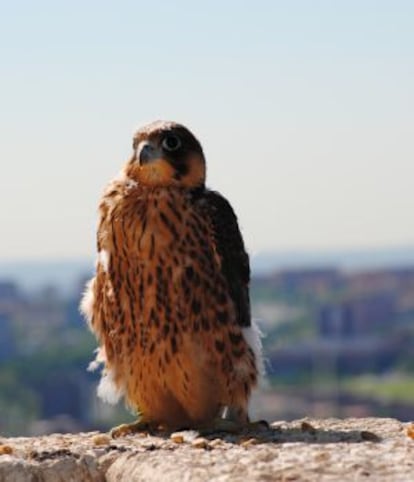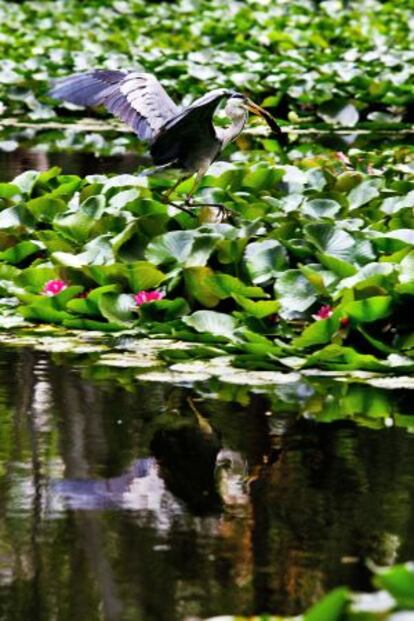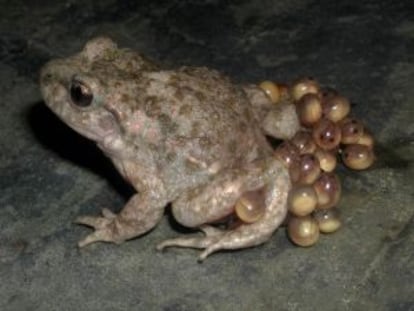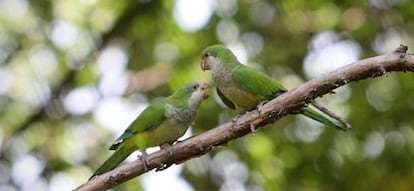The hidden wildlife of Spain’s cities
Urban spaces harbor an unexpected diversity of flora and fauna, which need protection

It’s a gray, early spring morning in Madrid, and people are hurrying by, most of them staring at the ground or into their smartphones. Arantza Leal, however, is looking up into the sky, focused on a tall building close to the capital’s Retiro park. She’s looking for a pair of peregrine falcons that have nested in the area in previous years.
There are at least eight pairs of these protected birds in Spain’s most-populous city. As life becomes harder in their original habitats, they have steadily moved into urban areas, where they find shelter in the many tall buildings, and are able to feed off pigeons, or the parakeets that have also settled here. There are few other birds able to compete with them, says Leal, a biologist at the SEO Birdlife NGO, who keeps a close eye on Madrid’s avian population. “I’ve seen goshawks and even vultures,” she adds.

“The city is not a desert. In fact, it is much more populated than we imagine,” says Raimundo Real, professor of biology at the University of Málaga. Humans, he explains, alter their environment, expelling many other species as we take over areas, while at the same time leaving spaces open for others, creating new ecosystems that birds, rats, squirrels, rabbits, hedgehogs, and bats, not to mention toads, frogs, lizards, insects and, perhaps most surprisingly, owls and even foxes are able to occupy. A study carried out by Rutgers University in around 150 cities worldwide last year estimated that each had an average of 112 species of birds, and 766 trees and plants, the majority of which were native.
That said, cities are not the friendliest of environments for flora and fauna: the Rutgers study showed that only five percent of plants and 20 percent of birds worldwide live in urban habitats. But in a world that is becoming increasingly urbanized – 54 percent of humanity now lives in cities, a figure expected to rise to 66 percent by 2050 – there are growing calls, among them from the United Nations and the European Commission, for conservation strategies to protect urban biodiversity.

A number of cities in Spain, among them Santander, Barcelona and Vitoria, are already drawing up biodiversity plans. Vitoria now belongs to a network created by the University of Virginia School of Architecture that includes San Francisco, Birmingham, Oslo and Singapore.
Barcelona’s biodiversity plan includes “ecological, environmental, social and even economic measures” that range from conserving nature, the physical and mental wellbeing of the population, reducing pollution and regulating temperatures and the water cycle, to research and education, generating value from buildings, and promoting tourism.
According to Joan Puigdollers, the head of Barcelona’s environment department, these cities recognize that plants are the main means by which the Earth captures CO2 and converts it into oxygen. A city’s green spaces can’t be compared to a rainforest, but in an increasingly urban world, we all have to do our bit: “It’s about taking advantage of any space, such as rooftops, gardens, squares, balconies…,” he says.

The Catalan capital’s plan calls for “environmental infrastructure as part of a complete system, with plant and animal life.” That’s to say, the idea is to move from purely decorative green spaces toward a self-sufficient ecosystem. This means greater numbers of older, leafy trees, along with areas filled with wild flowers, rather than manicured lawns, able to provide an ecosystem for a wide range of creatures.
“They are part of a greater whole, with independent areas. Any loss is a loss for the whole,” explains Real about one of the most basic principles of how ecosystems work – the idea that each life is related to that next to it. Ladybirds eat the bugs that attack plants; nightingales and other birds eat the insects that damage plants and bother people, as do toads, which also clean ponds when they are tadpoles. The birds of prey that hunt at night, such as the owls in Madrid’s Retiro park, reduce mice populations, while during the day, the falcons keep pigeon numbers down.
Conserving these delicate balances means an end to fumigation, and cutting back trees, as well as dealing with the presence of invasive species such as tortoises and parakeets.

Walking along the newly created riverside by the Casa de Campo, the huge park on Madrid’s northwestern edge, Juan Carlos del Moral and Luis Martínez of SEO Birdlife, explain the dangers presented by monk parakeets, which first appeared here at the end of the 1970s, when people released them into the wild or they escaped. There are now thousands of them, and as well as being noisy, their large nests damage trees. “This is something that could have been dealt with easily a long time ago, but now getting rid of them is going to be very costly,” says Del Moral.
Aside from the raucous parakeets, the pair of ornithologists are also able to identify storks, swifts, wagtails, starlings, tits, and many other species here. But they point out that the river walk is hardly an example of how to create an inclusive urban environment that helps wildlife and flora: there is no river bank, there are no flowers on the grass areas, and the lack of birds around indicates the problem. “Birds are a good indicator of the health of a city,” says Del Moral, explaining that blood samples from sparrows are an effective way of measuring air quality.

The sparrow has already largely disappeared from many European cities, including Madrid, although a few still hold out. As we look up to the Madrid sky, a flock of swifts passes overhead, returning from southern Africa after the winter. But most of the people around us seem unaware of this curious animal that spends most of its life on the wing: they eat, sleep, and breed in the air, only resting to incubate and raise their young. When summer comes, they will be a great help to us, eating the huge amounts of bothersome insects that also appear with the warm weather, such as mosquitoes, flies and moths.
Tu suscripción se está usando en otro dispositivo
¿Quieres añadir otro usuario a tu suscripción?
Si continúas leyendo en este dispositivo, no se podrá leer en el otro.
FlechaTu suscripción se está usando en otro dispositivo y solo puedes acceder a EL PAÍS desde un dispositivo a la vez.
Si quieres compartir tu cuenta, cambia tu suscripción a la modalidad Premium, así podrás añadir otro usuario. Cada uno accederá con su propia cuenta de email, lo que os permitirá personalizar vuestra experiencia en EL PAÍS.
¿Tienes una suscripción de empresa? Accede aquí para contratar más cuentas.
En el caso de no saber quién está usando tu cuenta, te recomendamos cambiar tu contraseña aquí.
Si decides continuar compartiendo tu cuenta, este mensaje se mostrará en tu dispositivo y en el de la otra persona que está usando tu cuenta de forma indefinida, afectando a tu experiencia de lectura. Puedes consultar aquí los términos y condiciones de la suscripción digital.
More information
Últimas noticias
The brief rise and retreat of Generation Z in Mexico
From safe-haven investment to geostrategic weapon: Who owns the most gold and where are the bars kept?
Todd Green, head of the company that created ‘Candy Crush’: ‘Success for us is that players want to play for years’
Prices soar and Venezuela’s economy struggles under Trump’s pressure: ‘People are living day to day’
Most viewed
- Why we lost the habit of sleeping in two segments and how that changed our sense of time
- Trump’s obsession with putting his name on everything is unprecedented in the United States
- Charles Dubouloz, mountaineering star, retires at 36 with a farewell tour inspired by Walter Bonatti
- Venezuela faces its most tense Christmas yet
- The Florida Keys tourist paradise is besieged by immigration agents: ‘We’ve never seen anything like this’










































